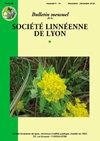Postia saxonica, a new species of Postia (Basidiomycota, Polyporales, Fomitopsidaceae) from Germany
Q4 Earth and Planetary Sciences
引用次数: 1
Abstract
A new polypore species, Postia saxonica (Basidiomycota), is described and illustrated. It was found in one locality in Germany, growing on the fungus Daedalea quercina. Macroscopically it remembers Postia hirsuta Shen & Cui (Shen & Cui, 2014), but differs by the presence of gloeopleurous hyphae, hymenial cystidioles and narrow, oblong-ellipsoid to cylindrical spores, up to 12 μm long. Its ecology and position within the genus is discussed.标题德国担子菌属(担子菌科,多孢子菌门,Fomitopsidaceae)一新种
描述并说明了一种新的多孔种——担子菌科(Postia saxonica)。它是在德国的一个地方发现的,生长在真菌代达利亚·奎奇纳上。从宏观上看,它记得Postia hirsuta Shen & Cui (Shen & Cui, 2014),但不同之处是存在gloepleous菌丝,膜囊泡和狭窄的,长至12 μm的长椭圆形到圆柱形孢子。讨论了它的生态学和在属中的地位。
本文章由计算机程序翻译,如有差异,请以英文原文为准。
求助全文
约1分钟内获得全文
求助全文
来源期刊
CiteScore
0.20
自引率
0.00%
发文量
0
期刊介绍:
Le Bulletin mensuel de la Société linnéenne de Lyon, depuis 1922, et le Bulletin hors série, depuis 2009, publient des études scientifiques originales consacrées à toutes les disciplines des sciences naturelles, et plus particulièrement de la taxonomie et l’inventaire de la biodiversité. Une rubrique « recueil de données naturalistes » permet de faire part d’observations intéressantes ou inédites.

 求助内容:
求助内容: 应助结果提醒方式:
应助结果提醒方式:


